A Guide to Community of Inquiry (CoI) Framework
The Community of Inquiry (CoI) framework is a transformative model for designing collaborative and engaging online learning environments. Learn more.
The Community of Inquiry (CoI) framework is a transformative model for designing collaborative and engaging online learning environments. Learn more.
%20Framework.webp)
Online education has become a frontier rather than a mere alternative to traditional learning methods. Now that learning transcends walls and time zones, the real challenge is cultivating connection, critical thinking, and meaningful dialogue in digital spaces.
That's where the Community of Inquiry (CoI) framework comes in. It's a powerful, research-backed model that reimagines how we structure online and blended learning experiences. Three of its essential elements include cognitive presence, social presence, and teaching presence.
However, these are not just abstract ideas. They are the building blocks of intellectually rich learning communication. The CoI framework equips instructional designers to create experiences that ignite creative, critical thinking. Below, we discuss how to implement this framework in online learning experiences.
The Community of Inquiry (CoI) Framework is a research-based model that provides a blueprint for creating deep, engaging, and intellectually stimulating online learning environments. It was developed by Garrison, Anderson, and Archer in 2000.
The framework is built on the premise that meaningful learning emerges through the intersection of three core presences: cognitive, social, and teaching.
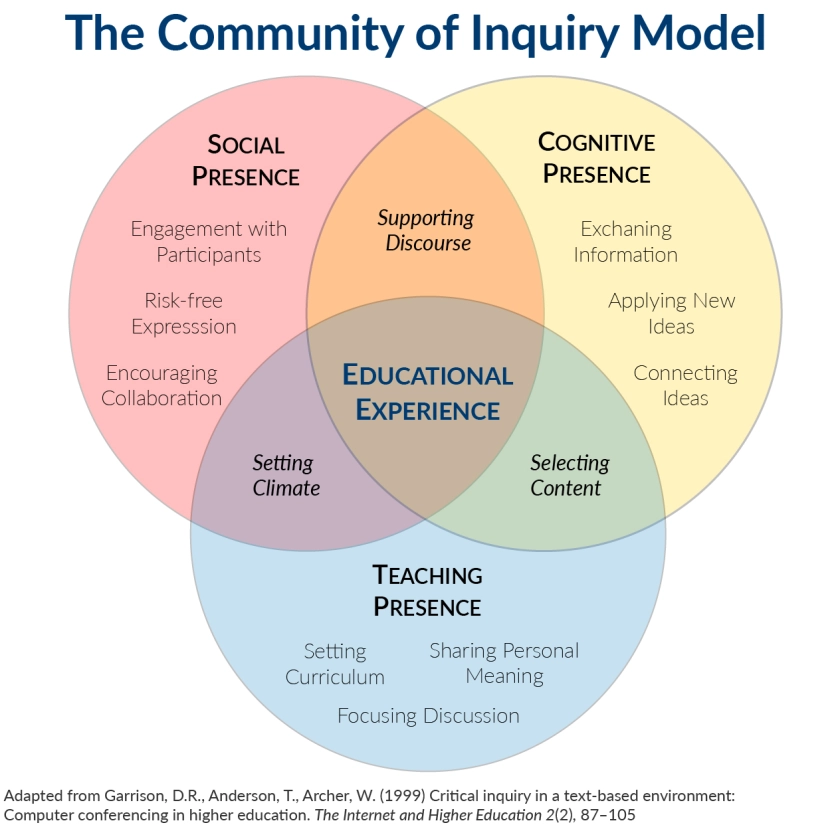
Let's discuss these three presences in detail.
Cognitive presence is all about how learners construct meaning through sustained reflection and critical discourse. It's the intellectual engine of the CoI model.
In organizational contexts, cognitive presence refers to how employees make sense of complex information, connect ideas across departments, and co-create solutions through reflective dialogue.
Take Deloitte, for instance. In their internal leadership development programs, participants don't simply get handed content. Instead, they engage in case-based discussions and scenario simulations where they analyze real-world business dilemmas. This way, teams can move from surface understanding to actionable insight through peer-led analysis and asynchronous forums.
Even the best training fails if people don't feel safe, seen, or connected. Social presence is about creating a psychologically safe environment where employees feel comfortable sharing ideas, giving feedback, and learning from one another.
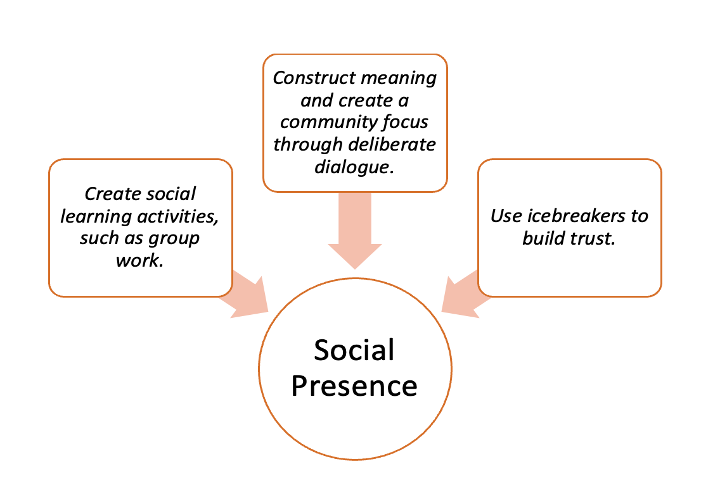
For example, an organization could create collaborative spaces for mentors and mentees to co-author learning paths. Here, learners can share project reflections and engage in informal, peer-to-peer discussions through Slack or video. The human layer turns training into a relationship-driven journey.
In the CoI framework, teaching presence doesn't refer to a facilitator on a Zoom call or an avatar in an online course. It's the strategic orchestration of content and activities that guides participants toward meaningful outcomes.
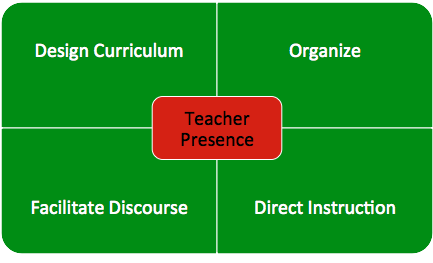
In an organization, this could mean blending live facilitation with self-paced modules and micro-coaching. Instructors can also hold Q&A sessions where learners can ask questions and clarify doubts.
The CoI framework can help organizations build eLearning programs that are content-rich, human-centered, reflective, and transformative. To start, it moves learning from passive to purposeful.
Traditional eLearning often emphasizes content delivery over meaningful engagement. Learners watch a video. Take a quiz. Click "next."
The CoI framework shifts the focus from knowing to understanding and then to doing. When cognitive, social, and teaching presences are intentionally designed into a program, learning becomes an active process of inquiry, not just consumption.
It also intentionally builds social presence to allow learners to form connections that break down organizational silos and foster cross-functional dialogue. The collaborative energy leads to breakthrough thinking.
CoI's focus on teaching presence also equips learning leaders with a method to create meaningful learning journeys through elements like pacing, tone, responsiveness, and presence (even if asynchronous).
More importantly, the CoI framework provides a scalable foundation to deliver personalized and collaborative learning at scale. It empowers L&D teams to create resilient and adaptable programs.
When you design an online course in an organization, you have to create a space where people think deeply and grow together purposefully. The Community of Inquiry (CoI) framework offers a structured way to do exactly that.
We'll use the example of a mid-sized software firm rolling out a product management certification for its cross-functional employees to explain the steps involved in this process.
The foundation of a successful learning experience begins with teaching presence. That means the learning team should just determine what they need people to know about the topic (i.e., project management).
Instead, they ask themselves:
Based on these answers, the instructional designer will then map out learning outcomes. These will be centered around strategic thinking and cross-functional alignment.
Since great learning doesn't take place in isolation, social presence is a must. Learners must have the opportunity to present themselves authentically and interact openly.
To build this in, you must not treat learners like anonymous users in a system. Instead, maybe you could host a welcome day where participants introduce themselves via short video clips and share one product idea they wish existed. It's a small activity, but it can help break the ice.
Then, throughout the course, you can assign the learners to rotating peer pods of 4 to 5 people. They can work together on group reflections and case studies. Similarly, they may have informal Slack channels and "Ask Me Anything" sessions with senior product leaders.
In our example from earlier, the participants would be able to go beyond just sharing tasks with this approach. They would challenge assumptions, offer feedback, and provide support to each other. That's social presence in action.
Cognitive presence is what makes learning "stick." It's the extent to which learners construct meaning through reflection, exploration, and dialogue.
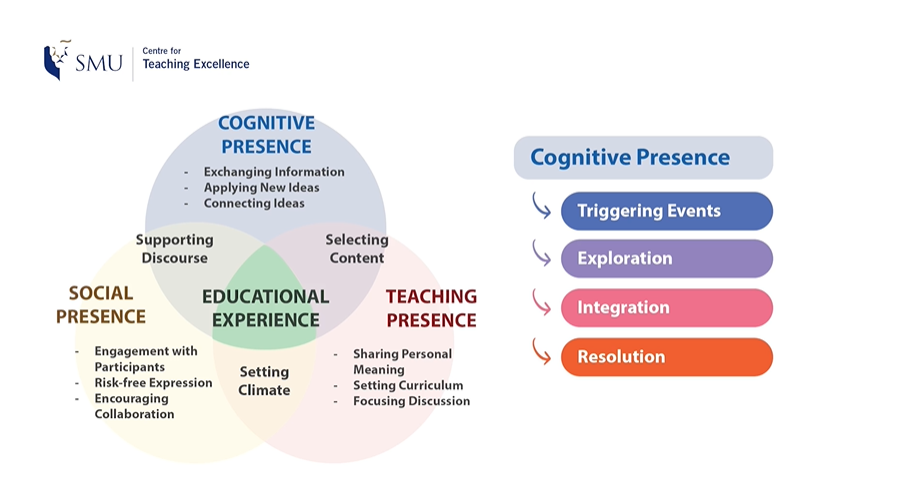
Rather than delivering static lessons, you can frame each week with open-ended, problem-based prompts. For example, in the project management course, instead of teaching about road mapping with a lecture, learners can be asked:
"You've been asked to defend your roadmap to a skeptical executive team. What trade-offs will you need to justify, and how will you back up your choices?"
Learners can then discuss their ideas in peer pods and draw mock roadmaps in shared workspaces. From there, they can present their responses in short video pitches for feedback.
This way, you design every activity to stimulate thought, comparison, analysis, and synthesis. Some key cognitive presence actions to keep in mind are:
By the end of the course, learners would not just be able to apply project management frameworks but also think like product managers.
Don't limit teaching presence to design. Facilitators should take a highly engaged role in any kind of learning experience.
For example, they shouldn't just grade assignments but also ask follow-up questions and find patterns across cohorts. If a particular group falls silent, facilitators should check in privately to understand why. Similarly, if a discussion gets stuck on surface-level responses, they introduce counterpoints or direct learners back to the course objectives.
Such a style of facilitation creates a culture of dynamic support. You can take it up a notch by providing real-time AI chatbot support to learners through Coursebox. The course-building platform has a built-in chatbot that trains on your course material to provide 24/7 assistance to students.
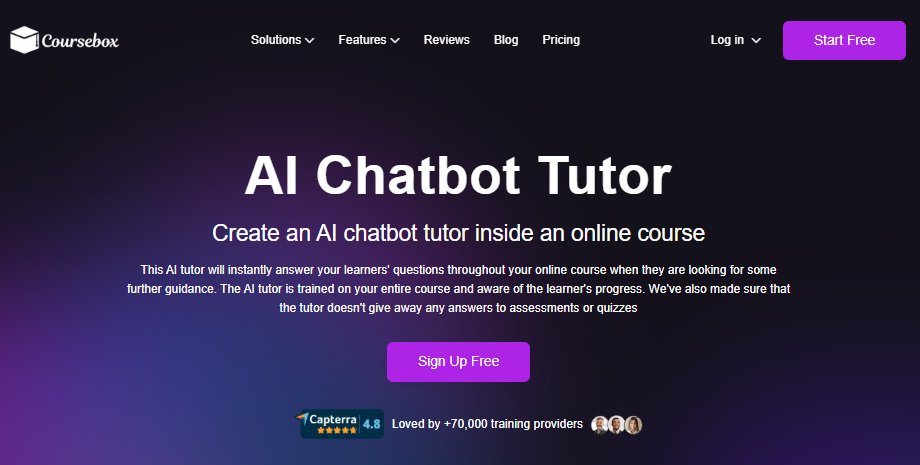
In this scenario, there's an additional teaching presence in the form of an AI chatbot that helps learners navigate through the course content and provides instant clarification on any doubts they may have.
As your course comes to a close, don't just issue certificates and move on. In the final week, ask participants to write personal reflection letters that answer how their thinking has changed during the course duration. You can also ask them to create 90-day application plans with goals tailored to their role.
These closing activities reinforced learning as an ongoing process, not a one-time event. Plus, they help learners internalize and articulate what they've learned.
Designing online learning in organizations can be transactional or transformational. The difference often lies in whether you treat learning as a content-delivery task or a community-building opportunity.
The CoI framework offers a roadmap for the latter. When you combine teaching presence (design and facilitation), social presence (authentic connection), and cognitive presence (purposeful inquiry), you create online courses that spark insight and fuel performance.
Such courses succeed because they create spaces where people learn with each other and not just from a screen, resulting in higher engagement and ongoing learning. That's exactly what the future of organizational learning should look like.
Get started for free today.
